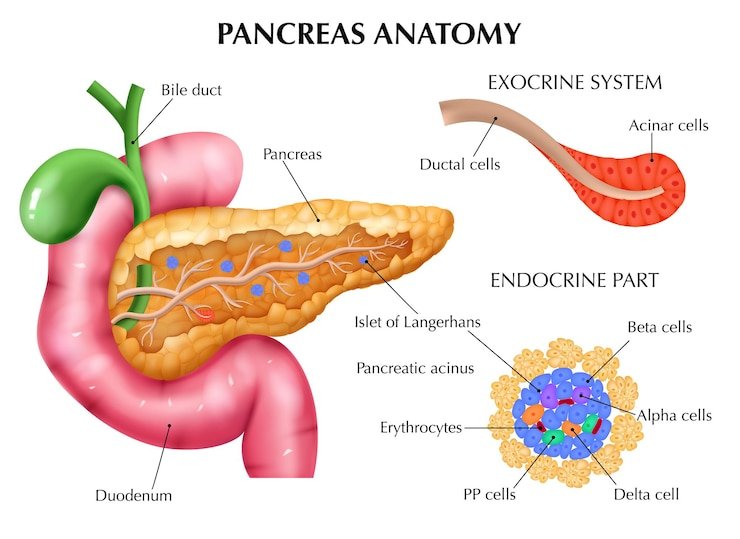The pancreas is a vital organ located in the abdomen, playing a crucial role in digestion and blood sugar regulation. This beginner’s guide will explore the anatomy and functions of the pancreas in a simplified manner.Best Gastroenterologist in Rohini.
To Know More About It Please Click Here
Anatomy of the Pancreas
The pancreas is a long, flattened gland situated deep within the abdomen, behind the stomach. It extends horizontally across the abdomen, with its head nestled into the curve of the duodenum (the first part of the small intestine) and its tail reaching toward the spleen. The pancreas has both endocrine and exocrine functions:
- Exocrine Tissue: This makes up about 95% of the pancreas and consists of clusters of cells called acini. These cells produce digestive enzymes that are released into the duodenum through a network of ducts. The digestive enzymes are essential for breaking down carbohydrates, proteins, and fats in the food we eat.
- Endocrine Tissue: The remaining 5% of the pancreas is made up of specialized cells known as islets of Langerhans, which have endocrine functions. These islets contain different types of cells, including beta cells that secrete insulin and alpha cells that secrete glucagon. These hormones play a critical role in regulating blood sugar levels.
Functions of the Pancreas
- Digestion: The pancreas produces and secretes digestive enzymes into the small intestine to help break down carbohydrates, proteins, and fats into smaller molecules that can be absorbed by the body. The main enzymes produced by the pancreas include amylase (for carbohydrates), proteases (for proteins), and lipase (for fats).
- Blood Sugar Regulation:
- Insulin: Beta cells in the pancreas release insulin when blood sugar levels rise after a meal. Insulin helps cells absorb glucose from the bloodstream, lowering blood sugar levels and allowing cells to use glucose for energy or storage.
- Glucagon: When blood sugar levels drop, alpha cells in the pancreas release glucagon. Glucagon signals the liver to break down glycogen into glucose and release it into the bloodstream, thereby raising blood sugar levels.Best Gastroenterologist in Rohini.
Common Pancreatic Disorders
- Pancreatitis: This is inflammation of the pancreas and can be acute (sudden and short-lived) or chronic (long-term). It can be caused by gallstones, excessive alcohol consumption, or certain medications.
- Diabetes: Diabetes mellitus type 1 occurs when the pancreas produces little or no insulin due to the autoimmune destruction of beta cells. Type 2 diabetes results from insulin resistance or reduced insulin secretion.
- Pancreatic Cancer: This is a serious cancer that often has a poor prognosis due to its late detection. Risk factors include smoking, obesity, and family history.
To Know More About It Please Click Here
Conclusion
The pancreas is a remarkable organ with dual functions critical to digestion and metabolism. Its exocrine and endocrine tissues work in harmony to ensure proper digestion of food and maintenance of blood sugar levels. Understanding the anatomy and functions of the pancreas is essential for appreciating its importance in overall health and wellness.Best Gastroenterologist in Rohini.


